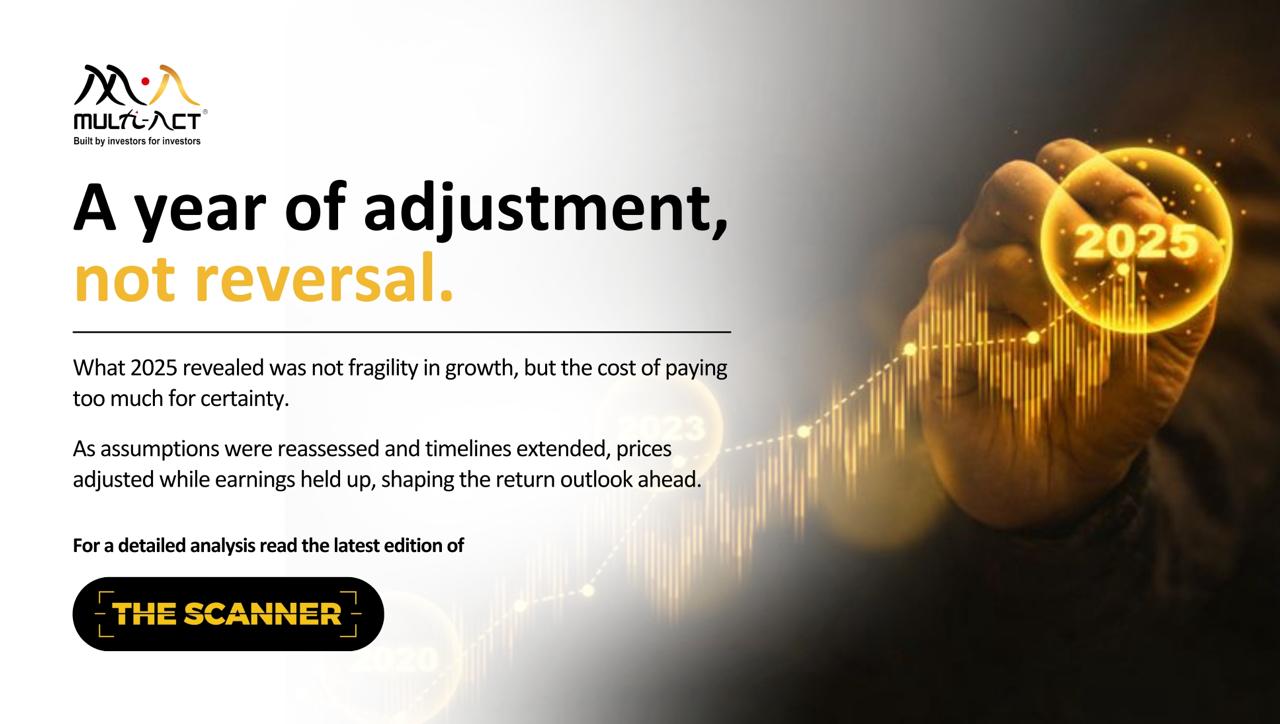
What Happened and What’s in Store for 2026
2025 did not challenge growth. It challenged assumptions. As expectations moved ahead of actual delivery, prices adjusted … Continued
Read more12 June 2019

When you look at the investing community, there are basically two kinds of investors – those who want to “get rich” and those who want to “stay rich”. While the “stay rich” investors, by definition, would already be “rich”, the “get rich” investors could include not only those that are “not rich” currently but also those that are “rich” currently but are hungry for more.
It is very important for an investor to clearly identify the category that he fits into. Also, it is important that the investor understands that this “category” cannot be a moving goal post. Most investors, in a down cycle, prefer “safety” and in an up-cycle, prefer “high returns”.
What is important is that an “investor” needs to identify his category, make peace with it, and stick to it in “good times” and “bad”. Shifting categories frequently only leads to behavioural errors and this, we think, is the main reason why investors generally have a bad experience in the stock markets.

When an “investor” decides the “category” he belongs to, he should also pay attention to his current level of affluence. The basic question is “do you want to risk what you have for what you don’t have?”. Logically, a person who is already rich “might” not want to risk what he has for what he does not have. Similarly, a person who wants to get rich “might” want (or need) to risk what he has for what he does not have.
However, in the real world, risk-taking depends a lot on behaviour and “DNA” than on pure logic. So, you need to be honest with yourself when classifying yourself into these investor categories. Let’s take a look at the Risk profiles for each of the four investor types:
Type A – These are generally retail investors who are very conservative and consider the “stock market” as a risky place to be in.
Type B – These are HNIs and UHNIs who have a high level of financial literacy.
Type C – These are generally retail investors who have a strong drive to get very high returns. They tend to chase returns and are willing to go down the quality curve (or very risky asset allocation) as long as it promises a high return. This strategy requires an ability and willingness to stay unperturbed through periods of massive drawdowns but can also lead to a very strong performance in bull markets.
Type D – These are HNIs and UHNIs who, despite being rich, are driven to achieve very high returns.
While it is easy to classify yourself into one of these four categories on Day 1, what generally happens is that you tend to digress towards another style in periods where your own style is underperforming, when compared to others.
For example, during a bull market, a Type A investor feels that he is underperforming as against a Type C investor and that he ought to take higher risks. And at the peak of the market, he tends to make the switch at precisely the worst of times. Similarly, a Type C investor, during a bear market, feels that all this risk-taking is not worth it and he needs to get into safety, again making the switch at the worst of times.
When investors compare investment alternatives, it is also very important for them to understand the risks that were taken to generate the returns that were generated. For example, compare a portfolio that generated 16% returns by 50:50 mix between “fixed income: equity” with a portfolio that generated 18% returns by 10:90 mix between “fixed income: equity”. Your choice of the portfolio depends entirely on the type of investor you are.
Type A and B would prefer the former portfolio, and Type C and D would prefer the latter portfolio. However, since some of the nuances of performance are not well-understood, money flows to the latter portfolio from even those investors for whom the incremental 200 bps returns are not worth the additional risk that stems from a higher equity allocation.
Every style goes through a period where it looks either out-of-favour or out-dated. And history also suggests that every style gets back in vogue. What is important for investors is to be true to their objectives, have realistic expectations, and not let envy get the better of themselves.
To summarise, here are some key takeaways for investors. When comparing investment alternatives, investors should not judge A versus B purely based on past returns. The nuanced measure of risk like “volatility”, “fall from peak” in bad times, “average equity weights” to get these returns, etc. should also be looked at. If dealing through an intermediary, investors should insist on these numbers to make holistic decisions.
Investors should classify themselves into one of the four categories mentioned above and stick to it in good times and bad. Switching from one category to another based on the flavour of the market is likely to hurt more than help. If dealing with an “advisor” or “intermediary”, the “investor” should make sure that the “advisor” or “intermediary” understands the investor’s risk profile and objectives and recommends “products/ schemes” suitable for such a profile.
Lastly, it is also important for Asset Managers (like PMSs) to have a well-defined “investment strategy” and a clear “target market” that they intend to cater to, through this strategy. A conservative “investment strategy” might underperform in a roaring bull market and might even lead to the “Asset Manager” losing clients during such a period. This should ideally not lead to the “Asset Manager” suddenly changing their strategy from “conservative” to “aggressive”, because every “Asset Manager” should have a core investment philosophy that cannot change based on what is “in” or “out” of favour.
At Multi-Act, we focus on providing reasonable returns with an endeavour to minimise drawdowns (drop from peaks). Our investment process tries to identify opportunities that could provide disproportionate gains for a given level of risk (downside). By consistently identifying such investments and our willingness to sit on cash when such opportunities are not available, we build portfolios that could provide superior risk-adjusted returns in the long run.

2025 did not challenge growth. It challenged assumptions. As expectations moved ahead of actual delivery, prices adjusted … Continued
Read more
Macro numbers alone rarely tell the full story. When jobs, consumption, credit, and inflation are considered together, … Continued
Read more
The AI story everyone sees is technological. The story that a few notice is financial. Revolving expenditures, … Continued
Read moreReceive monthly updates by signing up to our newsletter.
| Sr. No. | Received from | Pending at the end of last month | Received | Resolved* | Total Pending # | Pending complaints > 3 months | Average Resolution time^ (in days) |
|---|---|---|---|---|---|---|---|
| 1 | Directly from Investors | 0 | 0 | 0 | 0 | 0 | 0 |
| 2 | SEBI (SCORES) | 0 | 0 | 0 | 0 | 0 | 0 |
| 3 | Other Sources (if any) | 0 | 0 | 0 | 0 | 0 | 0 |
| Grand Total | 0 | 0 | 0 | 0 | 0 | 0 | |
Number of complaints received during month against the IA due to impersonation by some other entity: Nil
Note: In case of any complaints received against the IA due to impersonation of the IA by some other entity, the IA may adjust the number of such complaints from total number of received/resolved complaints while preparing the above table. Further, IA must close such impersonation related complaints after following the due process as specified by SEBI/ IAASB.
* Inclusive of complaints of previous months resolved in the current month.
# Inclusive of complaints pending as on the last day of the month.
^ Average Resolution time is the sum total of time taken to resolve each complaint in days, in the current month divided by total number of complaints resolved in the current month.
| Sr. No. | Month | Carried forward from previous month | Received | Resolved* | Pending# |
|---|---|---|---|---|---|
| 1 | April, 2025 | 0 | 0 | 0 | 0 |
| 2 | May, 2025 | 0 | 0 | 0 | 0 |
| 3 | June, 2025 | 0 | 0 | 0 | 0 |
| 4 | July, 2025 | 0 | 0 | 0 | 0 |
| 5 | August, 2025 | 0 | 0 | 0 | 0 |
| 6 | September, 2025 | 0 | 0 | 0 | 0 |
| 7 | October, 2025 | 0 | 0 | 0 | 0 |
| 8 | November, 2025 | 0 | 0 | 0 | 0 |
| 9 | December, 2025 | 0 | 0 | 0 | 0 |
| Grand Total | 0 | 0 | 0 | 0 | |
* Inclusive of complaints of previous months resolved in the current month.
# Inclusive of complaints pending as on the last day of the month.
| SN | Year | Carried forward from previous year | Received | Resolved* | Pending# |
|---|---|---|---|---|---|
| 1 | 2021-22 | 0 | 0 | 0 | 0 |
| 2 | 2022-23 | 0 | 0 | 0 | 0 |
| 3 | 2023-24 | 0 | 0 | 0 | 0 |
| 4 | 2024-25 | 0 | 0 | 0 | 0 |
| Grand Total | 0 | 0 | 0 | 0 | |
* Inclusive of complaints of previous years resolved in the current year.
# Inclusive of complaints pending as on the last day of the year.